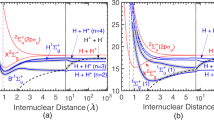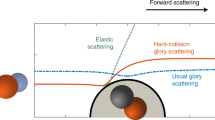Abstract
Interferences are genuine quantum phenomena that appear whenever two seemingly distinct classical trajectories lead to the same outcome. They are common in elastic scattering but are seldom observable in chemical reactions. Here we report experimental measurements of the state-to-state angular distribution for the H + D2 reaction using the ‘photoloc’ technique. For products in low rotational and vibrational states, a characteristic oscillation pattern governs backward scattering. The comparison between the experiments, rigorous quantum calculations and classical trajectories on an accurate potential energy surface allows us to trace the origin of that structure to the quantum interference between different quasiclassical mechanisms, a phenomenon analogous to that observed in the double-slit experiment.
This is a preview of subscription content, access via your institution
Access options
Subscribe to this journal
Receive 12 print issues and online access
$259.00 per year
only $21.58 per issue
Buy this article
- Purchase on Springer Link
- Instant access to full article PDF
Prices may be subject to local taxes which are calculated during checkout
 HD(v′ = 1, j′) + D at a mean collision energy of 1.97 eV.
HD(v′ = 1, j′) + D at a mean collision energy of 1.97 eV.
 HD(v′ = 3, j′) + D at an average collision energy of 1.97 eV.
HD(v′ = 3, j′) + D at an average collision energy of 1.97 eV.
 HD(v′ = 1, j′ = 0) + D reaction at Ecoll = 1.97 eV.
HD(v′ = 1, j′ = 0) + D reaction at Ecoll = 1.97 eV.



Similar content being viewed by others
References
Aoiz, F. J., Bañares, L. & Herrero, V. J. The H + H2 reactive system. Progress in the study of the dynamics of the simplest reaction. Int. Rev. Phys. Chem. 24, 119–190 (2005).
Jankunas, J. et al. Seemingly anomalous angular distributions in H + D2 reactive scattering. Science 336, 1687–1690 (2012).
Jankunas, J. et al. Is the simplest chemical reaction really so simple? Proc. Natl Acad. Sci. USA 111, 15–20 (2014).
Schnieder, L. et al. Experimental studies and theoretical predictions for the H + D2 → HD + D reaction. Science 269, 207–210 (1995).
Aoiz, F. J. et al. The O(1D) + H2 reaction at 56 meV collision energy: a comparison between quantum mechanical, quasiclassical trajectory, and crossed beam results. J. Chem. Phys. 116, 10692–10703 (2002).
Skodje, R. T. et al. Resonance-mediated chemical reaction: F + HD → HF + D. Phys. Rev. Lett. 85, 1206–1209 (2000).
Bernstein, R. B. Extrema in velocity dependence of total elastic cross sections for atomic beam scattering: relation to di-atom bound states. J. Chem. Phys. 37, 1880–1881 (1962).
Da Silveira, R. Rainbow interference effects in heavy ion elastic scattering. Phys. Lett. B 45, 211–213 (1973).
Ford, K. W. & Wheeler, J. A. Semiclassical description of scattering. Ann. Phys. 7, 259–286 (1959).
Levine, R. D. & Bernstein, R. B. Molecular Reaction Dynamics and Chemical Reactivity (Oxford Univ. Press, 1987).
Gijsbertsen, A., Linnartz, H., Taatjes, C. A. & Stolte, S. Quantum interference as the source of steric asymmetry and parity propensity rules in NO−rare gas inelastic scattering. J. Am. Chem. Soc. 128, 8777–8789 (2006).
Eyles, C. J. et al. Interference structures in the differential cross-sections for inelastic scattering of NO by Ar. Nature Chem. 3, 597–602 (2011).
Nichols, B. et al. Steric effects and quantum interference in the inelastic scattering of NO(X) + Ar. Chem. Sci. 6, 2202–2210 (2015).
McCurdy, C. W. & Miller, W. H. Interference effects in rotational state distributions: propensity and inverse propensity. J. Chem. Phys. 67, 463–468 (1977).
Dai, D. et al. Interference of quantized transition-state pathways in the H + D2 → D + HD chemical reaction. Science 300, 1730–1734 (2003).
Berteloite, C. et al. Kinetics and dynamics of the S(1D2) + H2 → SH + H reaction at very low temperatures and collision energies. Phys. Rev. Lett. 105, 203201 (2010).
Dong, W. et al. Transition-state spectroscopy of partial wave resonances in the F + HD reaction. Science 327, 1501–1502 (2010).
Monks, P. D. D., Connor, J. N. L. & Althorpe, S. C. Nearside−farside and local angular momentum analyses of time-independent scattering amplitudes for the H + D2 (v i = 0, j i = 0) → HD (v f = 3, j f = 0) + D reaction. J. Phys. Chem. A 111, 10302–10312 (2007).
Goldberg, N. T., Zhang, J., Miller, D. J. & Zare, R. N. Corroboration of theory for H + D2 → D + HD (v′ = 3, j′ = 0) reactive scattering dynamics. J. Phys. Chem. A 112, 9266–9268 (2008).
Boothroyd, A. I., Keogh, W. J., Martin, P. G. & Peterson, M. R. A refined H3 potential energy surface. J. Chem. Phys. 104, 7139–7152 (1996).
Greaves, S. J., Murdock, D., Wrede, E. & Althorpe, S. C. New, unexpected, and dominant mechanisms in the hydrogen exchange reaction. J. Chem. Phys. 128, 164306 (2008).
Greaves, S. J., Murdock, D. & Wrede, E. A quasiclassical trajectory study of the time-delayed forward scattering in the hydrogen exchange reaction. J. Chem. Phys. 128, 164307 (2008).
Dobbyn, A. J., McCabe, P., Connor, J. N. L. & Castillo, J. F. Nearside–farside analysis of state-selected differential cross sections for reactive molecular collisions. Phys. Chem. Chem. Phys. 1, 1115–1124 (1999).
Rackham, E. J., Gonzalez-Lezana, T. & Manolopoulos, D. E. A rigorous test of the statistical model for atom–diatom insertion reactions. J. Chem. Phys. 119, 12895–12907 (2003).
Panda, A. N. et al. A state-to-state dynamical study of the Br + H2 reaction: comparison of quantum and classical trajectory results. Phys. Chem. Chem. Phys. 14, 13067–13075 (2012).
Koszinowski, K., Goldberg, N. T., Pomerantz, A. E. & Zare, R. N. Construction and calibration of an instrument for three-dimensional ion imaging. J. Chem. Phys. 125, 133503 (2006).
Jankunas, J., Sneha, M., Zare, R. N., Bouakline, F. & Althorpe, S. C. Disagreement between theory and experiment grows with increasing rotational excitation of HD(v′, j′) product for the H + D2 reaction. J. Chem. Phys. 138, 094310 (2013).
Skouteris, D., Castillo, J. F. & Manolopoulos, D. E. ABC: a quantum reactive scattering program. Comp. Phys. Comm. 133, 128–135 (2000).
Aoiz, F. J., Herrero, V. J. & Sáez Rábanos, V. Quasiclassical state to state reaction cross sections for D + H2(v = 0, j = 0) → HD(v′,j′) + H. Formation and characteristics of short-lived collision complexes. J. Chem. Phys. 97, 7423–7436 (1992).
Bonnet, L. & Rayez, J. C. Quasiclassical trajectory method for molecular scattering processes: necessity of a weighted binning approach. Chem. Phys. Lett. 277, 183–190 (1997).
Bañares, L., Aoiz, F. J., Honvault, P., Bussery-Honvault, B. & Launay, J.-M. Quantum mechanical and quasi-classical trajectory study of the C(1D) + H2 reaction dynamics. J. Chem. Phys. 118, 565–568 (2003).
Acknowledgements
The authors acknowledge funding by the Spanish Ministry of Economy and Competitiveness (grants CTQ2012-37404-C02 and Consolider Ingenio 2010 CSD2009–00038) and the US National Science Foundation (CHE-1151428).
Author information
Authors and Affiliations
Contributions
R.N.Z. and F.J.A. conceived and designed the research. M.S. and J.J. conducted the photoloc technique experiments, and P.G.J. and D.H.A. carried out the QM and QCT calculations. P.G.J., F.J.A. and R.N.Z. wrote the paper, with contributions from all co-authors.
Corresponding authors
Ethics declarations
Competing interests
The authors declare no competing financial interests.
Supplementary information
Supplementary information
Supplementary information (PDF 989 kb)
Rights and permissions
About this article
Cite this article
Jambrina, P., Herráez-Aguilar, D., Aoiz, F. et al. Quantum interference between H + D2 quasiclassical reaction mechanisms. Nature Chem 7, 661–667 (2015). https://doi.org/10.1038/nchem.2295
Received:
Accepted:
Published:
Issue Date:
DOI: https://doi.org/10.1038/nchem.2295
This article is cited by
-
Observation of the geometric phase effect in the H+HD→H2+D reaction below the conical intersection
Nature Communications (2020)
-
Direct observation of forward-scattering oscillations in the H+HD→H2+D reaction
Nature Chemistry (2018)
-
Dynamical importance of van der Waals saddle and excited potential surface in C(1D)+D2 complex-forming reaction
Nature Communications (2017)
-
In situ dynamic tracking of heterogeneous nanocatalytic processes by shell-isolated nanoparticle-enhanced Raman spectroscopy
Nature Communications (2017)



